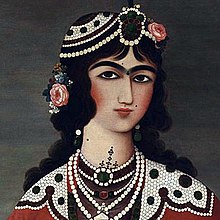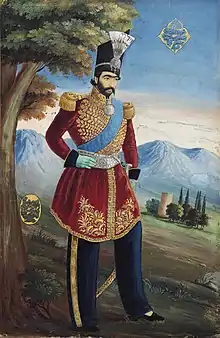Jeyran (wife of Naser al-Din Shah)
Jeyran (Persian: جیران; born Khadijeh Khanum Tajrishi (خدیجه خانم تجریشی), 1860–1831) was one of the beloved wives and first[1] mistress of Nasser al-Din Shah Qajar. Known for her beauty and charm, the story of Naser al-Din Shah's love for her gradually penetrated into popular culture. It became a symbol of Iranian love and has been compared to the story of Khosrow and Shirin by Nizami Ganjavi.[2]
| Jeyran | |
|---|---|
 Jeyran, or possibly Asieh Khanum the wife of Agha Mohammad Khan Qajar | |
| Born | Khadijeh Khanum Tajrishi 1831 |
| Died | 1860 (aged 28–29) Tehran, Iran |
| Spouse | |
| Issue |
|
Early life
Jeyran was born in 1831 in Tajrish village near Tehran: named "Khadijeh" she was the daughter of Mohammad Ali, a gardener and carpenter.[3] As well as a sister,[4] Jeyran had a brother named Asadullah, who after her marriage to the Shah became a servant and later a special adviser to Nasser al-Din Shah.[5]
Meeting Naser al-Din Shah

There are different opinions about how Naser al-Din Shah and Jeyran became acquainted. According to Abbas Amanat, Jeyran was first brought to the royal palace to learn singing and dancing, and for the first time Naser al-Din Shah saw her among the servants of his mother, Malek Jahan Khanom, and fell in love with her.[6]
In his memoirs, Taghi Khan Daneshvar (Alam al-Sultan), the Shah's personal violinist, attributed their acquaintance to one of the Shah's hunting trips to the north of Tehran. He wrote that Naser al-Din Shah was fascinated by her courage and beauty.[7]
In his book, From Forough Al-Dawlah to Anisa Al-Dawlah, Khosrow Motazed says the young Naser al-Din Shah met Jeyran during one of his trips to Shemiran, the Qajar kings' resort. According to him, at their first meeting Jeyran did not recognize the Shah, and while sitting on a mulberry tree and eating berries, she disregarded the Shah, considering him an annoying stranger, speaking with pride and arrogance:
'... The king greeted her slowly. This was the first time that the king of kings greeted one of his subjects ... The girl looked at him with contempt and disregard. She glanced at the king and said, "Go leave me alone ... Go, stranger, go and get lost ..." , Naser Al-Din Shah proposed to her and thus Jeyran joined the Shah's wives.'
— [8]
Mones al-Dawla (court lady of Anis al-Dawla) in her memoirs, also considers that Jeyran met the Shah on one of his travels and tells a similar story. According to her, the Shah, who had met a group of girls under a berry tree during his outing, including Jeyran, was seduced by her black eyes and sent his eunuchs to ask her name and find her father. Then he proposed to her and Jeyran answered in the affirmative.[9]
Regardless of which quote is more authoritative, the important point is that the meeting between Nasser al-Din Shah and Jeyran was a chance encounter. Jeyran was a rural girl from one of the deprived classes of society. Naser al-Din Shah, despite having other women, experienced love with Jeyran for the first time, and his love for her gradually reached the level of insanity; so that he could not bear the moments of distance of his mistress.[10]
Habits and characteristics
Jeyran was beautiful, straightforward and fascinated by hunting and horseback riding. She wore men's boots and clothes while riding, wrapped her veil around her head, and agilely rode horses.[11] She loved riding her chestnut horse, "Ahoo", into the mountains and flying her royal falcon "Ghazal" after partridge. At these times a large group of archers, warriors and servants would be gathered around her, so that if anyone saw this scene they would think it was a royal hunting party.[12] After she married Nasser al-Din Shah, she was named "Jeyran" (meaning gazelle) by the Shah because of her big eyes.[3]
Jeyran's fascination with hunting and bold behavior, unlike the usual veiled harem women, attracted the king's attention more and more. According to Abbas Amanat, "the Shah's attachment to Jeyran was the routine of ordinary love in the modern age and, conversely, the collective life of the harem was individual and private."[13]
Mistress and powerful at the court
in 1851, Nasser al-Din Shah married Jeyran. In the ceremony that was organized on the occasion of this marriage, Malik Jahan Khanom, the mother of Nasser al-Din Shah, was not present, which was a sign of her opposition and enmity with Jeyran.[14] One year after Jeyran married Nasser al-Din Shah, her first child, Sultan Mohammad Mirza, was born and died eight days later. Then her second child, Mohammad Qasim Mirza, was born, and from that day on, the Shah paid more attention to her. When Mohammad Qasim Mirza was five years old, the Shah gave him the title of Amir Nezam and appointed him commander-in-chief of the army.[15]
After the death of Nasser al-Din Shah's second crown prince, Soltan Moin ed-Din Mirza, son of Taj al-Dawla, in October 1856, Nasser al-Din Shah decided to appoint Muhammad Qasim as Crown prince.[16] But Jeyran's non-Qajar lineage prevented this decision from being implemented. Aware of her position, Jeyran tried to put pressure on Mirza Aga Khan Nuri. She collaborated with some courtiers opposed to Nuri, including Mirza Yusuf Ashtiani and Aziz Khan Mokri. In June 1867, they compiled a list of the crimes of Mirza Agha Khan, and Jeyran presented the list of crimes to the Shah.[17] After this incident, Nuri invited Jeyran to his garden, Nizamieh, and promised her to do his best for the crown prince of Mohammad Qasim. With Nuri's support for Jeyran, Malek Jahan Khanom, who was a serious opponent of Jeyran and Mohammad Qasim, turned against Mirza Agha Khan.[18]
Mirza Aga Khan entered into negotiations with the representatives of the Russian and British governments to persuade them to support Mohammad Qasim Mirza as crown prince. He also asked Jakob Eduard Polak, a court physician, to confirm that Muzaffar al-Din Mirza, who was considered a legal choice for crown prince, was physically and mentally weak and didn't deserve to ascend to be king. The preparation of a fake lineage that linked Jeyran's lineage to the Ilkhanate and Sassanid kings was another step in legitimizing Crown Prince Mohammad Qasim Mirza.[19]
Finally, in September 1857, Mohammad Qasim was officially proclaimed Crown Prince. Shortly afterwards, Mohammad Qasim Mirza became ill, and the opposition made it known that Mirza Agha Khan had poisoned the Crown Prince, making Jeyran and Shah suspicious of Mirza Agha Khan again.[20] Concerned about his opponents' conspiracies, Jeyran refused to admit doctors to his son's bedside, and Mohammad Qasim Mirza died just one week after becoming crown prince. Naser al-Din Shah and Jeyran were so moved by the incident that, according to Polak, "the king did not eat for several days out of grief."[21][22]
Death
Jeyran contracted tuberculosis after losing all four of her children in childhood, one after the other. Naser al-Din Shah went to her bed several times a day for several hours and administered the medicine with his own hands, but her condition gradually got worse and the medical treatment did not help.[23] Jeyran died one day in January 1860 while Naser al-Din Shah was sitting next to her bed.[24]
Legacy
Naser al-Din Shah lived for thirty years after Jeyran's death and, according to many sources, did not forget her for the rest of his life. According to Dost Ali Moayeri, the Shah never gave the title of Jeyran and did not allow anyone to live in her mansion. Sometimes he would go to his wife's former residence alone and spend some time thinking about the past and seeing Jeyran's relics.[25] Nasser al-Din Shah wanted to be buried next to Jeyran, and after his assassination in 1896, he was buried next to her.[26]
In the popular culture of the Iranian people, Jeyran and Nasser al-Din Shah were introduced as a symbol of love and are often compared to Khosrow and Shirin.[27] The reason why Naser al-Din Shah took refuge in his harem for the rest of his life is also considered to be the result of Jeyran's death.[28] Nasser al-Din Shah wrote poems about Jeyran in which he praised her beauty and how painful her death was.[29]
In popular culture
Shahrzad director Hassan Fathi is making a series based on Jeyran's life called "Jeyran".[30][31]
References
- Azad, Hassan (1999). Gosheh hai az Tarikh Egtemai-e Iran: Posht Pardeh Haram [Corners of Iran's social history: behind the scenes of the harem] (in Persian). p. 356. ISBN 9789646614000.
Nasser al-Din Shah had given her the title of Forough al-Saltanah, which at that time officially meant mistress. And Forough was the first to receive this title
- Amanat, Abbas. Qebleh-ye 'ālam [Pivot of the Universe] (in Persian). Tehran: Karnameh. p. 421. ISBN 964-431-049-7.
- Abbas Amanat, Qebleh-ye 'ālam [Pivot of the Universe], p. 422
- Mehdi Qoli Hedayat, Memories and dangers, p. 31
- , Political Memoirs of Amin al-Dawla
- Abbas Amanat, Qebleh-ye 'ālam [Pivot of the Universe], p. 423
- Saadvandian, Cyrus. Dar Khalvat-e Sultan [In the privacy of the Sultan] (in Persian). p. 471. ISBN 9789648155518.
- Motazed, Khosrow; Tafzali, Abolghasem. Az Forough Al-Saltanah ta Anis Al-Dawlah [From Forough Al-Saltanah to Anis Al-Dawlah] (in Persian). pp. 140–141. ISBN 9789645527288.
- Mones al-Dawla, Fatemeh. Saadvandian, Cyrus (ed.). Khaterat Mones al-Dawla, Nadimeh Naser al-Din Shah [Memoirs of Mones al-Dawla, court lady of Nasr al-din Shah harem] (in Persian). Zarin. pp. 229–230. ISBN 9789644072536.
- Khosrow Motazed, from Forough Al-Saltanah to Anis Al-Dawlah, p. 143
- Abbas Amanat, Qebleh-ye 'ālam [Pivot of the Universe], p. 424
- Moayeri, Dost Ali. Yaddasht Hai az Zendegi-e Khososi-e Naser al-Din Shah [Notes from the private life of Nasser al-Din Shah Qajar] (in Persian). Tehran: Tarikh Iran. p. 18.
- Abbas Amanat, Qebleh-ye 'ālam, p. 425
- Etemad Al-Saltanah, Mohammad Hassan (1889). Al-Mathir va Al-Athar [Exploits and monuments] (in Persian). 2. p. 46.
- Abbas Amanat, Qebleh-ye 'ālam [Pivot of the Universe], p. 426
- Abbas Amanat, Qebleh-ye 'ālam [Pivot of the Universe], p. 427
- Ghaem Maghami, Jahangir. "Payan-e Mirza Agha Khan Nuri Etemad Al-Dawlah" [The end of Mirza Aga Khan Nuri Etemad Al-Dawlah]. Journal of Historical Studies (in Persian). 3: 97–144.
- Farrokhzad, Pooran. Karnameh Zanan-e Ghodratmand-e Iran az Diroz ta Emroz [The career of powerful women in Iran from yesterday to today] (in Persian). p. 801. ISBN 9789643411169.
- Khosrow Motazed, from Forough Al-Saltanah to Anis Al-Dawlah, p. 145-146
- EʿTEMĀD-AL-DAWLA, ĀQĀ KHAN NŪRĪ The fatal illness and death of the new heir apparent in Ḏu’l-ḥejja 1274/July 1858 faced Āqā Khan with a new crisis as Jeyrān accused him of poisoning her son. The shah did not go along with this unfounded charge but nonetheless criticized the premier’s conduct
- Khosrow Motazed, from Forough Al-Saltanah to Anis Al-Dawlah, p. 146
- Abbas Amanat, Qebleh-ye 'ālam [Pivot of the Universe], p. 428
- Dost Ali Moayeri, p. 39
- Abbas Amanat, Qebleh-ye 'ālam [Pivot of the Universe], p. 429
- Dost Ali Moayeri, p. 40
- Dost Ali Moayeri, p. 41
- Amanat, Abbas. Qebleh-ye 'ālam [[Pivot of the Universe]]. Tehran: Karnameh. p. 421. ISBN 964-431-049-7.
- Abbas Amanat, Qebleh-ye 'ālam [Pivot of the Universe], p. 430
- Saadvandian, Cyrus. In the privacy of the Sultan. p. 473.
- "'The Times' director begins new project". ifilm-آیفیلم. Retrieved 14 January 2021.
- "Director Hassan Fat'hi focuses on Qajar king's favorite Jeyran in new series". Tehran Times. 28 June 2020. Retrieved 14 January 2021.